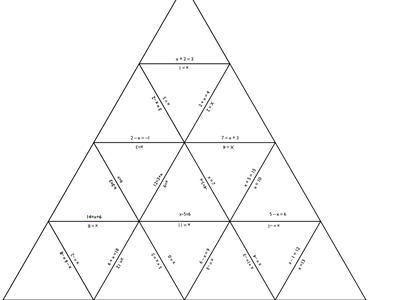Solving equations with algebra mats
Year level: Year 7
Strand: Algebra
Lesson length: 60 mins
In this lesson, students are introduced to solving one-variable linear expressions using a variety of concrete materials, which are related to authentic contexts to enhance their understanding.
This is the third lesson in a series of lessons to develop understandings and proficiency in algebraic thinking.

Curriculum information
Achievement standard
Students use algebraic expressions to represent situations, describe the relationships between variables from authentic data, and substitute values into formulas to determine unknown values. They solve linear equations with natural number solutions.
Content description
Students solve one-variable linear equations with natural number solutions; verify the solution by substitution. AC9M7A03
General capabilities
Numeracy:
Critical and Creative Thinking:
- Interpret concepts and problems (Level 5)
Assessment
The following formative assessment items are suggested for this lesson:
- Students respond to the question ‘In your own words, what does “solving” an equation mean?’
- Students complete the Tarsia puzzle and submit their completed puzzle.
Use the information provided by students in the exit ticket to inform the beginning discussion in the lesson, ‘Solving equations with algebra tiles’, ensuring any misconceptions about what it means to solve an equation are clarified. Consider students’ confidence levels in engaging with the mild/medium/spicy question sets.
Areas of challenge
Some students may:
- think that the ‘=’ sign indicates to record an example, rather than expressing an equivalence relationship
- think that a particular variable always holds the same value
- find identifying inverse integer operations counterintuitive, particularly when negative integers are involved
- forget, or not realise, they need to do the same thing to both sides of the equation
- have trouble neatly recording each step of their working out when solving equations.
Prerequisite student knowledge and language
Prior to this lesson, it is assumed that students have knowledge of:
- the concept of variables
- constructing equations from word problems
- conventions associated with the order of operations for integers
- knowledge of algebraic conventions (covered in prior lessons)
- how ‘=’ indicates an equivalence statement
- how to substitute values into equations
- how to model equations and substitute values using cups and counters.
What you need:
Lesson plan (Word)
Teacher's slides (PowerPoint)
Solving equations worksheet (Word)
Tarsia puzzle (PDF)
Algebra mat template (Word)
Cups and counters (per student pair)
Mini whiteboards/markers (optional)
Learning goals
Learning intention
- We are learning to construct equations for given word problems.
- We will substitute values into equations.
- We will solve equations involving addition and subtraction.
Success criteria
By the end of the lesson, students can:
- solve one-step equations involving addition and subtraction with and without concrete materials.
Why are we learning about this?
Equations are useful in many everyday scenarios – including representing our wages – or for formulas for finding the area of a shape or the density or volume of an object. Solving equations allows us to easily explore a range of phenomena in the real world and solve a wide variety of problems.
Learning hook 15 mins
Connect to prior learning
To launch the lesson, students can complete questions from GeoGebra's Evaluating expressions. Note that this activity was provided as a suggested link to use in the prior lesson in this sequence, ‘Expressions, formulas and substitution’.
Differentiation (enable): Allow students to work in pairs to facilitate collaborative learning. Provide mini whiteboards and markers to support students engaging in the activity effectively.
Learning hook
Slides 1 and 2 introduce students to the learning intentions of the lesson. Remind them that this lesson follows on from what was previously learnt about constructing algebraic equations and substituting values. Explicitly explain that in this lesson you will continue to construct algebraic expressions, and that you will be solving equations.
Explore 30 mins
Solving equations using cups and counters
Pre-prepare by downloading and printing out the downloadable worksheets found in the ‘What you need’ section from the online lesson.
Using the slides 3–7, introduce students to solving equations using cups and counters. Note, you would have used cups and counters in the previous lessons: ‘Formulating algebraic expressions’ and ‘Expressions formulas and substitution’. See the teaching notes section of each slide for teacher explanation. This part is a class–teacher dialogue.
Differentiation (enable): Provide pairs of students with cups and counters, and allow them to model each problem while following along with the explicit introduction to the concept.
Enable students to explore the concept
Have students work in groups of two or three. Distribute the student worksheets, and give out the cups and counters to students to use (if they wish). Observe and support each of the groups throughout this part of the lesson.
Differentiation (all abilities): The Solving equations worksheet allows students to attempt as many questions as they like from the difficulty levels ‘mild’, ‘medium’
and ‘spicy’.
Iteration: Group students by ability so that those who have connected with algebra can delve into the ‘spicy’ questions, OR mix groups by ability and encourage students to collaborate, exchange ideas and instruct each other.
Summary and reflection 10 mins
Consolidate the concept
Now that students have explored solving equations with concrete materials, introduce them to the formalised idea of ‘what you do to one side, you have to do to the other’ (slides 8–11).
Students can then complete the Tarsia puzzle and submit their completed puzzle as an exit ticket.
Differentiation (enable): Students can complete the Tarsia puzzle collaboratively in pairs.